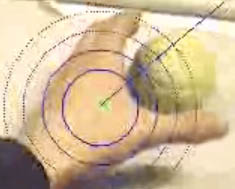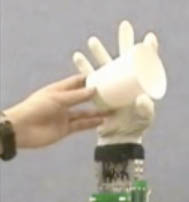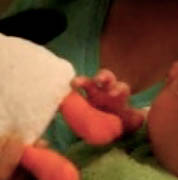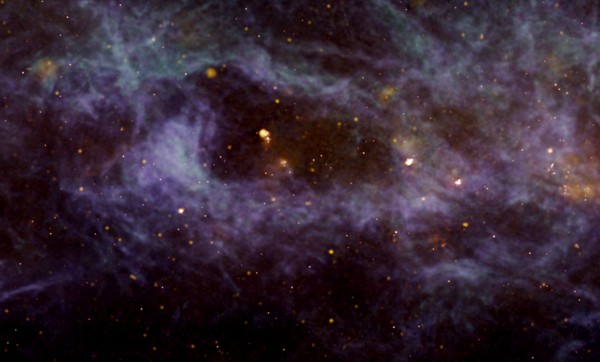
|
Lorna Mills and Sally McKay
Digital Media Tree this blog's archive OVVLvverk Lorna Mills: Artworks / Persona Volare / contact Sally McKay: GIFS / cv and contact |
View current page
...more recent posts



Grasping is a big deal in neuroscience. It's one of the first things we do, and we happen to be pretty good at it. Mirror neurons were discovered when scientists were looking at a monkey's brain function during grasping. Grasping is a big deal because of prosthetic design, robot design and the lingering fascination with AI.
The frontal lobe is big in humans and this probably accounts for why we get up to so much complicated business like global capitalism and network technologies and art that animals don't bother with. The frontal lobe takes care of planning and evaluating and setting goals. But it is also responsible for motor control. Recently on Dr. Ginger Campbell's Brain Science Podcast, Dr. Art Glenburg explained a bit about the study of embodied cognition, which explores the hypothesis that "high level cognition is really based on lower level processes," such as "neural systems that control action, neural systems that control perception, and neural systems that control emotion." This work in cognitive psychology predates the discovery of mirror neurons in neuroscience. Mirror neurons add emphasis to the concept that the "brain evolved for action."
On Saturday I attended the afternoon session of Subtle Technologies. I always love that conference, even though its art/science amalgamation is sometimes awkward and goofy. The organisers, Jim Ruxton and Sachiko Hirosue, are really good at riding out the discomfort that arises from weird juxatopositions between the presenters. It's not a melding of minds, but a meeting of disciplines.

From The Hubble Space Telescope Gallery and Public Information, the caption on Jayanne English's website reads: "The radiation detected from the Hubble Space Telescope (HST) not only includes light that our eyes would see, but also radiation from the infra-red and and ultra-violet which we do not see."
One of my favourite talks was by Jayanne English, who works on "outreach images" for astronomy. She was part of the Hubble team that composed and colourised data from the Hubble telescope into the sumptuous space images that we see in magazines. English talked a lot about the politics of translating data into colour choices that would be visually interesting to a general audience. She said she had to do quite a bit of "inreach" initially, training the astronomers to understand image theory. One big problem is that the light at the "hot" end of the spectrum is represented in science as blue, while the "cool" end is red. Scientists sometimes think their data is being misrepresented if she inverts this convention so it'll make sense to the rest of us who think red is hot and blue is cool. But making the images scientifically informative is an important part of the mandate. She said that she is not interested in representing data as the eye would see it, as that is not useful to the science, nor particularly interesting to look at, as most of the information is outside the visible spectrum anyhow.
Lately English has been working with data from radio telescopes, which, she says gives her more leeway. There's more info and images here on her website.

National Radio Astronomy Observatory Image Contest - First Prize 2006. Image courtesy of NRAO/AUI and Jayanne English (U. Manitoba), Jeroen Stil and Russ Taylor (U. Calgary) and MSX. The caption on Jayanne English's website reads: "A Majestic Gas Shell Revealed by the VLA. -- This image, created by myself and Jeroen Stil with the support of Russ Taylor (U Calgary), shows cold hydrogen gas shell, GS 62.1+0.2-18, residing in the plane of our Milky Way Galaxy. One of the telescopes it uses is the VLA, the radio telescope array used in the movie Contact. Our eyes do not detect radiation so this gas is 'invisible' but very important to the formation of stars, planets and even life itself."